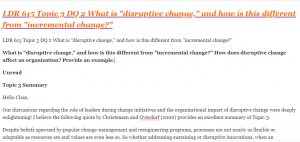LDR 615 Topic 3 DQ 2 What is “disruptive change,” and how is this different from “incremental change?”
LDR 615 Topic 3 DQ 2 What is “disruptive change,” and how is this different from “incremental change?”
What is “disruptive change,” and how is this different from “incremental change?” How does disruptive change affect an organization? Provide an example.
Topic 3 Summary
Hello Class,
Our discussions about the role of leaders during change initiatives and the organizational impact of disruptive change were extremely informative! The following quote from Christensen and Overdorf (2000), in my opinion, provides an excellent summary of Topic 3:
Contrary to popular change-management and reengineering programs, processes are not nearly as flexible or adaptable as resources, and values are even less so. So, whether addressing sustaining or disruptive innovations, managers must create a new organizational space where those capabilities can be developed when an organization requires new processes and values (pg. 72).
Christensen and Overdorf (2000) propose solutions such as creating new boundaries for existing organizational structures to facilitate new and improved processes or acquiring a new organization entirely to better facilitate new processes as a result of the change. It is worth noting that their solutions are primarily process-focused rather than people-centered. We also discussed the importance of not losing sight of “people” and employee buy-in during times of change in our discussions.
Unread
Replies
Disruptive change is a non-localized future irreversible and change in the organization that affects a portion of the healthcare

LDR 615 Topic 3 DQ 2 What is disruptive change, and how is this different from incremental change
industry/organization that does not affect a localized area but rather the entire valued network/organization (Smith, 2014). Disruptive change is one that is powerful, abrupt, and can lead to concerns when an organization does not choose to follow suit, and in result they may be left behind (Day, n.d.). The response of how the organization handles the disruptive change will affect the team members involved within the unprepared abrupt changes that are occurring.
Incremental change is when change occurs at a slower pace over time, less drastic and gradually develops changes/plans within the organization (Day, n.d.). Incremental change can improve efficiency, gives understanding, and build stronger rapport and moral within the organization.
Disruptive changes occur every day in our lives; however, the COVID-19 pandemic has caused an increase in disruption. The Covid-19 pandemic placed disruptive change, crisis mode, on many aspects of my organization from available resources, chain supply, staff, visitor policies, technology, and elective surgical cases being canceled, to list a few. With the changes that have occurred within my organization will/has affected the whole organization. An example of disruptive change that is currently occurring at my organization is the need to have to cancel elective surgeries either the night before, morning of, and in some cases when the patient arrives at the hospital due to not having enough hospital beds and/or staff at that very moment. With my hospital needing to cancel elective surgeries and if other hospitals are not needing to, it can cause our organization to lose patients to another organization especially when they are being canceled on the spot of arrival. Another example of disruptive change during the pandemic is technology and the use of telehealth/telemedicine visits. This has been a challenge for many patients since many may not have the technology tools to complete these visits, not educated clearly on how to use the tools and/or financially unable. Abrupt technology has caused patients difficulty in accessing their electronic health record portals and communicating to their provider through them. “A lot of the changes are so gradual that they don’t even qualify as news, or even as interesting: they’re so mundane that we just take them for granted. But history shows that it’s the mundane changes that are more important than the dramatic ‘newsworthy’ events”-Robert D Kaplan (Fingerprint for Success, n.d.).
References
Day, J. (n.d.). Incremental change vs disruptive innovation: What’s the difference?
Fingerprint for Success. (n.d.). Incremental change.
Smith, C. (2014). Meeting the challenge of disruptive change.
Unread
Replies,
Daily, the healthcare upheavals we’re witnessing are evolving and having effects we never could have anticipated. Changing policies and procedures on a weekly, if not daily, basis, depending on the current situation. We’re dealing with challenges with the supply chain, human resources, and the availability of beds, and we’re forced to juggle these concerns on a daily basis. Many people are worried about those who are learning to use the new telemedicine technology and may find themselves cut off from the loved ones they rely on for support as a result. The gradual introduction of telemedicine could help patients learn how it works and help them adapt to it. The epidemic did not allow for a gradual learning curve. We’re seeing patients who’ve been putting off seeking medical attention become more sicker than usual once they finally do, only to be diagnosed with cancer. The pandemic needs to be dealt with at the same time as we seek to bring routine health care back on the table for everyone.
Do you need a similar assignment written for you from scratch? We have qualified writers to help you.
You can rest assured of an A+ quality paper that is plagiarism free. Order now for a FREE first Assignment!
Use Discount Code "FREE" for a 100% Discount!
NB: We do not resell papers. Upon ordering, we write an original paper exclusively for you.

